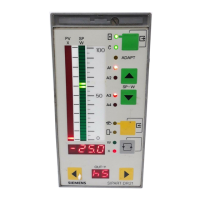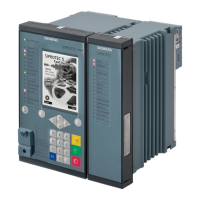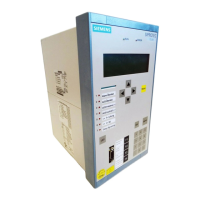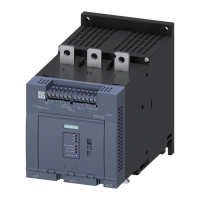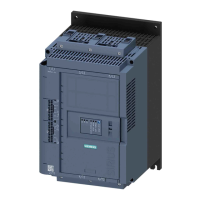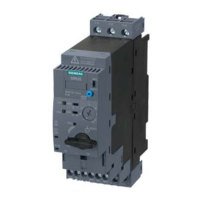1 Technical Description
1.5 Functional Description
1.5.8 Complex Functions (Arithmetic blocks c, d, h)
Manual
88
SIP ART DR24 6DR2410
C79000-G7476-C153-03
- tU: Monitoring time (parameterization mode AdAP)
tU is necessary for the error message only and has no influence on the identification
quality. tU must be set at least double the transient time T
95
of the controlled system. If
you have little knowledge of the controlled system, use tU = oFF (factory setting) for
adapting. After successful adaptation tU is automatically set to about 2T
95
.AttU< 0.1 h
(6 min), tU = oFF is displayed.
- dPv: Direction of the step command (parameterization mode AdAP)
The direction of the controlled variable change from the set working point is selected with
this configuring switch: x
Manual
Δx=ks (y
Manual
Δy). In controlled systems with
batches it is recommendable to perform adaptation with increasing x and falling x. The
averaged or dynamically more uncritical parameters can then be used for the control.
- dy: Amplitude of the step command (parameterization mode AdAP)
The step command must be selected so great that the controlled variable changes by at
least 5 % and the controlled variable change must be 5 times the average noise level.
The greater the controlled variable change, the better the identification quality. Controlled
variable changes of approx. 10 % are recommended.
- Unilinear controlled systems
In unilinear controlled systems several adaptations should be made at different load
states. The adaptation results and the controlling variable SG must be noted. The param-
eter sets determined in this way, related to the controlling variable SG, are then saved in
a function transmitter FUL (arithmetic block c) and this can then be switched to the con-
trolling input.
In this way ideal controller results can be achieved even on unilinear controlled systems.
- Notes on the adaptation results
D-part
In S--controllers and K--controllers on controlled systems of 1st order the D-Part brings no
noticeable advantages due to the finite positioning time Ty or for reasons founded in the
control theory. The disadvantages in the form of wear on the positioning side carry
greater weight.
Range limits
If one of the determined parameters reaches its range limits, the other parameter should
be adjusted slightly in the opposite direction of action.
If lines of the 8th order are identified, the determined Kp must be reduced for safety rea-
sons. If the control loop is then too slow, the Kp must be increased again in the manual
optimization.
kp variation
In the special case, controlled system of the 1st order in connection with PI and PID con-
trollers and controlled systems of the 2nd order in connection with PID controllers, the kp
can be varied freely. In controller design according to the amount optimum, Kp can be
increased up to 30 % as a rule without the control behaviour becoming critical.
